How to Open a Pkpass File in Windows 10
What is Maql virus?
Maql virus is a new ransomware that belongs to the family of ransomware called STOP (Djvu). Ransomware is a form of malware that encrypts the victim's files and demands a ransom for decrypting them. The Maql virus encrypts files, renames them by appending the .maql extension, and creates files named "_readme.txt" containing the ransom demand message. For example, a file named "image.jpg" will be renamed to "image.jpg.maql", a "document.docx" file to "document.docx.maql", "invoice.pdf" to "invoice.pdf.maql", and so on.
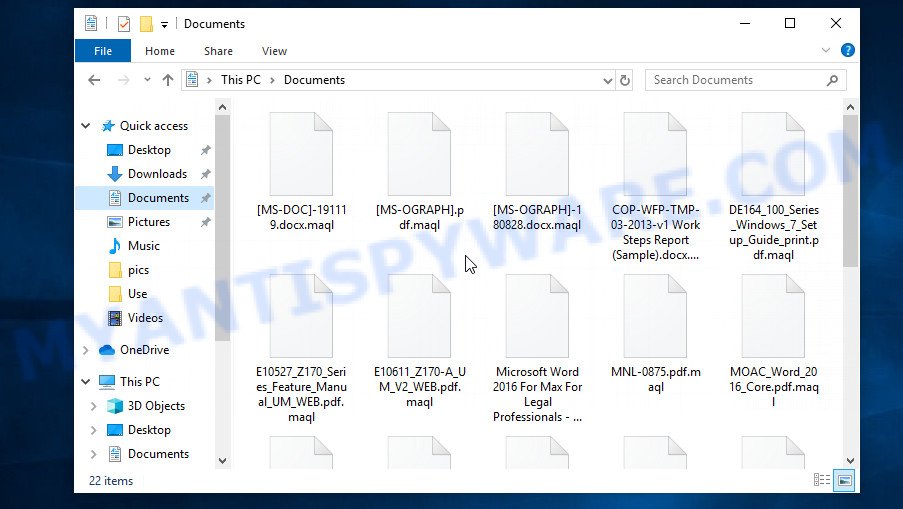
Screenshot of files encrypted by Maql virus ('.maql' file extension)
QUICK LINKS
- What is Maql virus?
- Remove Maql virus (ransomware)
- Decrypt .maql files
- Restore .maql files
- Video Guide
Maql ransomware is a malware that is distributed by websites offering to download torrents, cracked games, freeware, key generators, activators and so on. Upon execution, it creates a folder in the Windows system directory where it places a copy of itself and changes some Windows settings so that it starts up every time the computer is restarted or turned on. The virus collects information about the victim's computer and then tries to establish a connection with its command server (C&C). If the connection has been established, then it sends information about the infected computer to the server, and in response receives the encryption key (the so-called 'online key') and additional commands and malware that must be executed on the victim's computer. If the virus could not establish a connection with its command server, then it uses a fixed key (the so-called 'offline key').
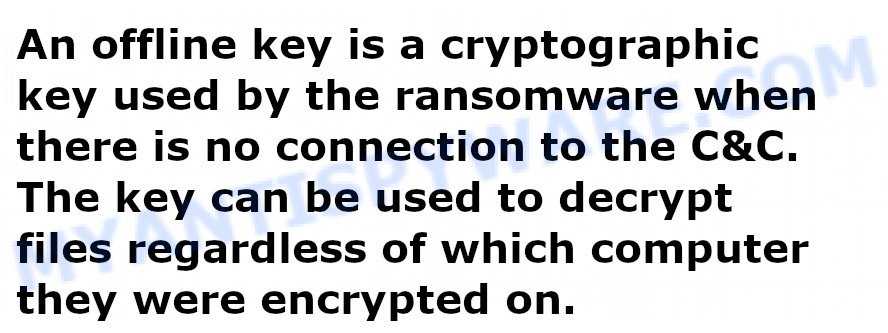
Maql virus encrypts files using a strong encryption algorithm and a long key ('offline key' or 'online key', as described above). The virus tries to encrypt as many files as possible, for this it only encrypts the first 154kb of the contents of each file and thus significantly speeds up the encryption process. Maql has the ability to encrypt files on all drives connected to the computer: internal hard drives, flash USB disks, network storage, and so on. It skips without encryption: files located in the Windows system directories, files with the extension .dll, .lnk, .ini, .bat, .sys and files with the name '_readme.txt'. The remaining files located on the victim's computer can be encrypted. For example, the following file types may be the target of ransomware attack:
.js, .xf, .w3x, .wb2, .gho, .css, .hplg, .xx, .yal, .cer, .pkpass, .wps, .xmind, .pptx, .lvl, .xld, .nrw, .sb, .mlx, .xyp, .wdb, .db0, .eps, .txt, .srw, .blob, .mrwref, .zip, .xlgc, .m2, .iwi, .bar, .mdbackup, .jpe, .rtf, .lrf, .doc, .layout, .itm, .pdd, .mef, .r3d, .xyw, .kf, .xbdoc, .d3dbsp, .wbmp, .docx, .xll, .vpk, .menu, .1st, .litemod, .wn, .ltx, .xls, .mov, .p7c, .wpd, .wsc, .xar, .hkx, .bc6, .forge, .sum, .wps, .cr2, .icxs, .sid, .x3d, .wsd, .xlsb, .wp4, .x3f, .t12, .wpt, .dazip, .odp, .vpp_pc, .xwp, .x, .tor, .pptm, .sr2, .docm, .orf, .xbplate, .ysp, .y, .mdf, .desc, .ibank, .big, .xlk, .dcr, .dng, .accdb, .lbf, .jpg, .das, .xml, .iwd, .zi, .webdoc, .fos, .xdl, .wpl, .mddata, .wm, .flv, .wma, .sis, .mp4, .wbd, .bsa, .pem, .sidn, .pdf, .sie, .wbk, .wav, .zif, .kdb, wallet, .xlsm, .x3f, .pak, .wmf, .zdb, .arch00, .webp, .rw2, .xy3, .sav, .erf, .snx, .cas, .upk, .zw, .psk, .epk, .bik, .esm, .mcmeta, .mdb, .wpe, .ff, .rgss3a, .wma, .zdc, .rim, .map, .ws, .fsh, .rofl, .wpa, .ztmp, .wp, .xdb, .z, .jpeg, .odm, .xls, .wp7, .rwl, .0, .wbc, .z3d, .wsh, .dmp, .svg, .qdf, .bkp, .slm, .crt, .p7b, .raw, .zip, .xpm, .sidd, .wmd, .3fr, .wotreplay, .hkdb, .dxg, .xmmap, .cdr, .xlsx, .t13, .ppt, .wri, .der, .avi, .wpg, .p12, .7z, .arw, .rb, .itl, .apk, .dba, .odc, .vcf, .bay, .cfr, .3dm, .fpk, .png, .syncdb, .vfs0, .xxx, .wpd, .ai, .itdb, .wcf, .py, .wbm, .1, .wp5, .odb, .hvpl, .indd, .wmv, .qic, .zabw, .psd, .vtf, .3ds, .dwg
Maql encrypts file-by-file. Each file that has been encrypted will be renamed, the .maql extension will be appended at the end of its name. This means the following. If the file had the name 'image.jpg', then after the virus encrypts it, this file will have the name 'image.jpg.maql'. In every directory where there is at least one encrypted file, the virus places a file named '_readme.txt'. The file contains a message from Maql authors. An example of the contents of this file is given below.
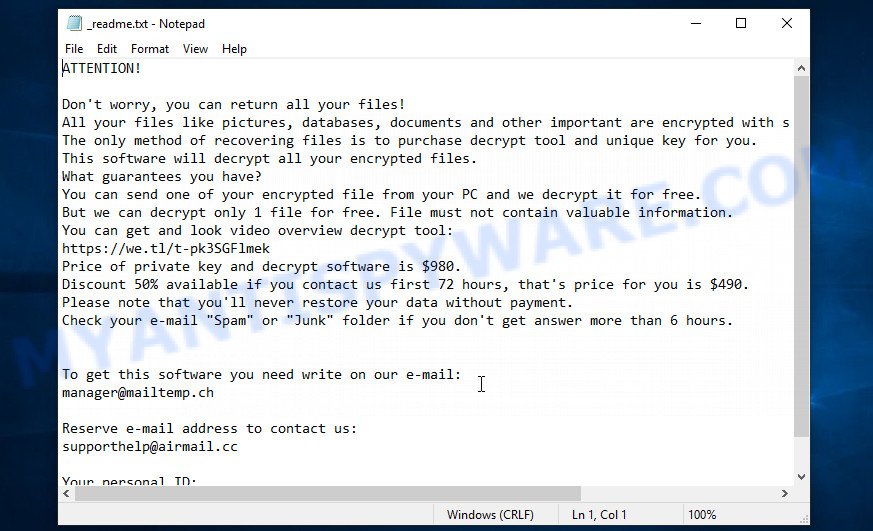
Screenshot of the contents of '_readme.txt' file (Maql ransom note)
This message says that all files on the computer are encrypted and the only way to decrypt them is to buy a key and a decryptor from the authors of Maql virus. That is, criminals demand a ransom for unlocking the victim's files. The size of the ransom is $980, but if the victim is ready to pay the ransom within 72 hours, then its size is halved to $490. Attackers offer victims to verify that encrypted files can be decrypted. To do this, the victim must send them a small file to one of the email addresses specified in the '_readme.txt' file. Of course, it is obvious that a single decrypted file cannot guarantee that after paying the ransom, the criminals will provide the victim with a working key and decryptor.
Text presented in the Maql ransom note:
ATTENTION!
Don't worry, you can return all your files!
All your files like pictures, databases, documents and other important are encrypted with strongest encryption and unique key.
The only method of recovering files is to purchase decrypt tool and unique key for you.
This software will decrypt all your encrypted files.
What guarantees you have?
You can send one of your encrypted file from your PC and we decrypt it for free.
But we can decrypt only 1 file for free. File must not contain valuable information.
You can get and look video overview decrypt tool:
https://we.tl/t-pk3SGFlmek
Price of private key and decrypt software is $980.
Discount 50% available if you contact us first 72 hours, that's price for you is $490.
Please note that you'll never restore your data without payment.
Check your e-mail "Spam" or "Junk" folder if you don't get answer more than 6 hours.To get this software you need write on our e-mail:
manager@mailtemp.chReserve e-mail address to contact us:
supporthelp@airmail.ccYour personal ID:
0340xxxxxxxx
Threat Summary
| Name | Maql virus, Maql ransomware |
| Type | Crypto malware, Ransomware, File locker, Crypto virus, Filecoder |
| File extension | .maql |
| Ransom note | _readme.txt |
| Contact | manager@mailtemp.ch, supporthelp@airmail.cc |
| Ransom amount | $980/$490 in Bitcoins |
| Detection Names | FileRepMalware, W32.AIDetect.malware2, Win32.Trojan.Kryptik.jm, UDS:Trojan.Win32.Chapak.gen, Trojan.Malware.300983.susgen, Packed-GDT!8DAA272F411B, Trojan:Win32/Glupteba, Trojan.Win32.Save.a, ML.Attribute.HighConfidence |
| Symptoms | Your documents, photos and music fail to open. Files are encrypted with a .maql file extension. Files named such as '_readme.txt', '#_README_#', '_DECRYPT_' or 'recover' in each folder with at least one encrypted file.. Ransom note in a pop-up window with cybercriminal's ransom demand and instructions. |
| Distribution methods | Malicious e-mail spam. Drive-by downloads (ransomware virus has the ability to infect the computer simply by visiting a web-site that is running malicious code). Social media posts (they can be used to force users to download malicious software with a built-in ransomware downloader or click a malicious link). Cybercriminals use malicious ads to distribute malicious software with no user interaction required. |
| Removal | Maql ransomware removal guide |
| Decryption | Maql File Decrypt Tool |
| Recovery | Maql File Recovery |
Security researchers confirm the words of the authors of Maql virus. All files with the extension '.Maql' are encrypted and thus cannot be read and used. The only way to decrypt them is to use the key and the decryptor. Fortunately, there is some good news. As we already reported above, Maql virus belongs to STOP ransomware family, which means that you can use a free decryptor created by Emsisoft to decrypt the encrypted files. Even if the decryptor does not help, there are some alternative ways that can help restore the contents of the encrypted files. To learn more about decrypting files, simply scroll down to section 'How to decrypt .maql files'. Read the entire manual carefully. To make it easier for you to follow the instructions, we recommend that you print it or open it on your smartphone.
How to remove Maql ransomware virus
Before you start decrypting or recovering .maql files, you need to remove Maql ransomware and its autostart entries. This must be done since otherwise the ransomware may re-encrypt the restored files. You can stop the ransomware from working, as it is not difficult to do. Another option is to perform a full system scan using free malware removal tools capable of detecting and removing ransomware infection.
It is very important to scan the computer for malware, as security researchers found that spyware could be installed on the infected computer along with the Maql ransomware. Spyware is a very dangerous security threat as it is designed to steal the user's personal information such as passwords, logins, contact details, etc. If you have any difficulty removing the Maql virus, then let us know in the comments, we will try to help you.
To remove Maql ransomware, follow the steps below:
- Kill Maql virus
- Disable Maql Start-Up
- Delete Maql Task
- Remove Maql virus
Kill Maql virus
Press CTRL, ALT, DEL keys together.
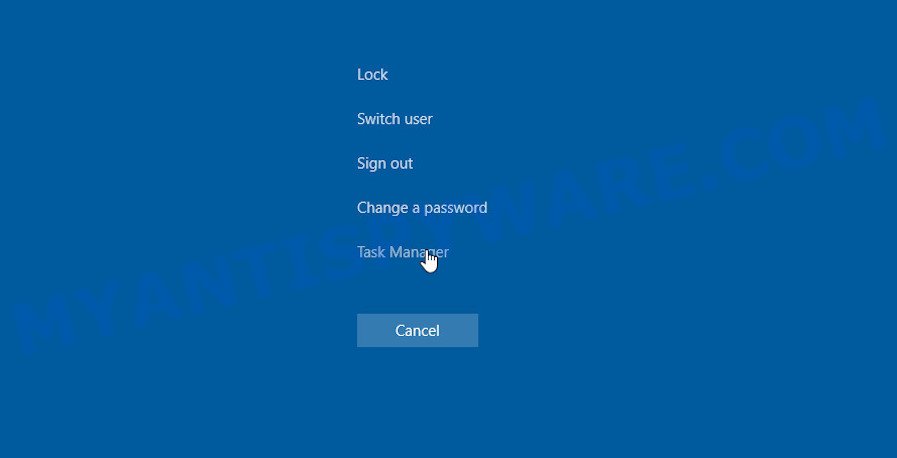
Click Task Manager. Select the "Processes" tab, look for something suspicious that is the Maql ransomware then right-click it and select "End Task" or "End Process" option. If your Task Manager does not open or the Windows reports "Task manager has been disabled by your administrator", then follow the guide: How to Fix Task manager has been disabled by your administrator.
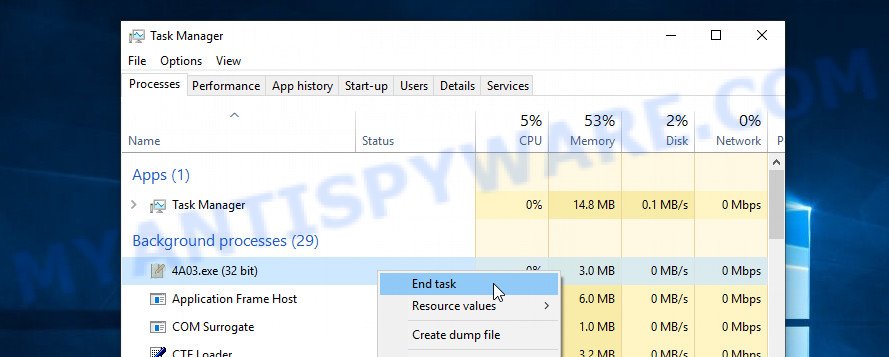
It is not difficult to detect a process related to the Maql ransomware. When looking for a malicious process, pay attention to the process icon and its name. Most often, this ransomware has a process name in the following format: 4-characters.tmp.exe or 4-characters.exe. For example: 7533.tmp.exe, A4b1.exe, CD15.tmp.exe, 19b2.exe. The process name can also contain "(32 bit)". If you do not find a process with a similar name in the list of processes, then most likely the Maql ransomware has finished working. But keep in mind, if you do not remove the ransomware autostart entries, as demonstrated below, and do not delete its file, then after a while it may start again, and if it finds unencrypted files, immediately encrypt them.
Disable Maql Start-Up
Select the "Start-Up" tab, look for something similar to the one shown in the example below, right click to it and select Disable.
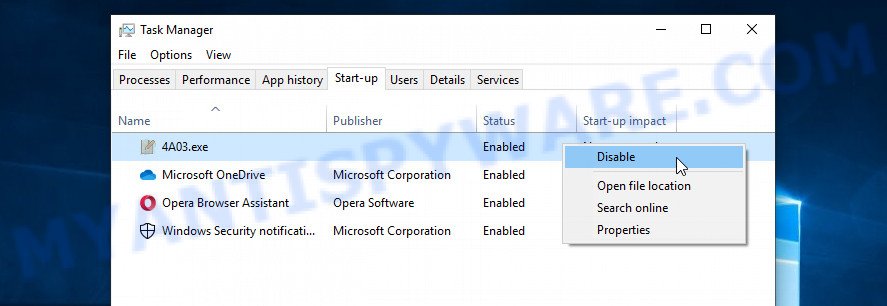
Close Task Manager.
Delete Maql Task
Type "Task Scheduler" in the search bar. Click Task Scheduler app in the search results. Click "Task Scheduler Library" in the left panel. On the right panel, right-click to "Time Trigger Task" and select Delete.
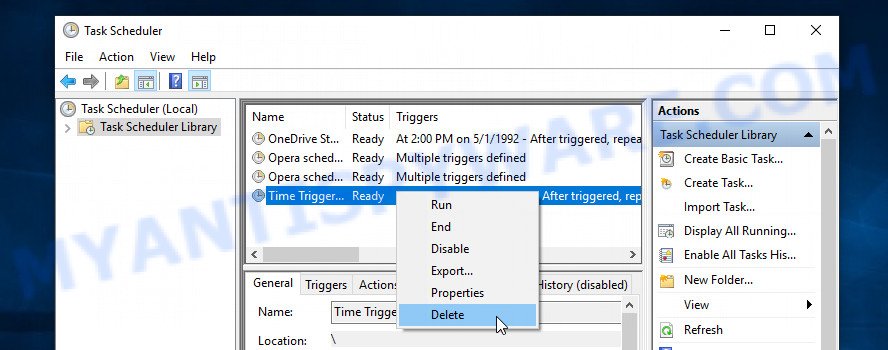
Close Task Scheduler.
Remove Maql virus
Run Task Manager and select the "Start-Up" tab. Right click to the Maql ransomware Start-Up entry and select Open File Location as shown below.
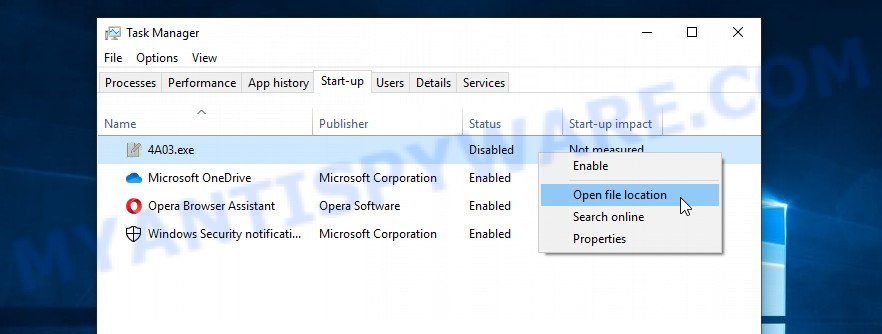
A directory containing one file will open in front of you, this file is the Maql virus. It needs to be removed. If you try to delete it immediately, then you will not succeed, since this file is protected from deletion.
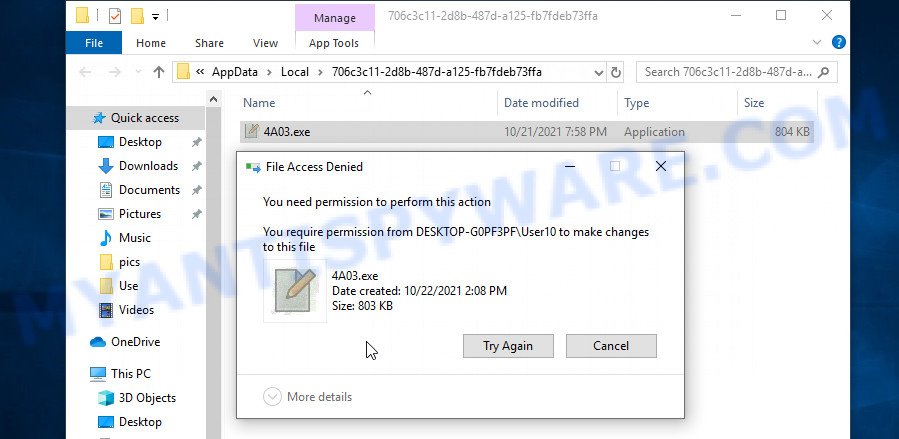
To delete this file, you need to do the following. Right-click on the file, select Properties. In the window that opens, select Security tab. Next, click the Advanced button below. A window will open as shown in the following example.
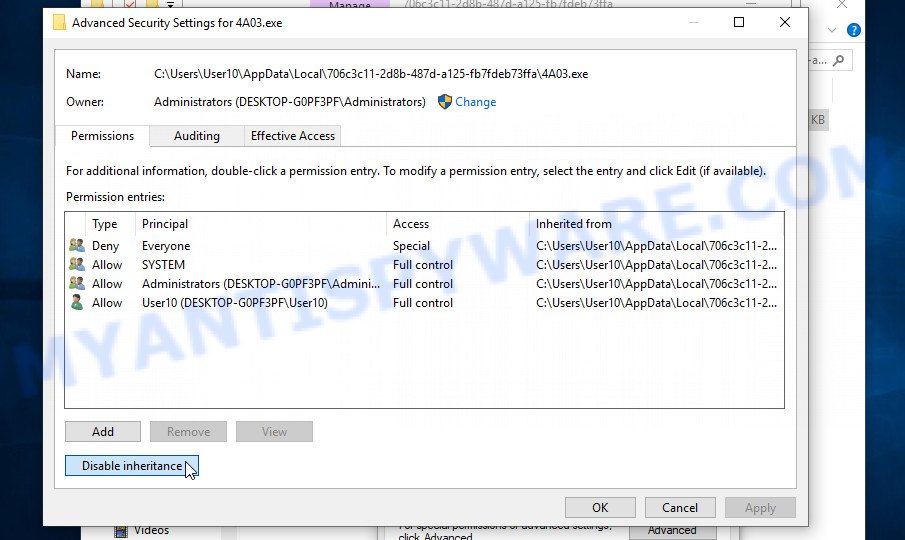
Click Disable inheritance. In the Block inheritance dialog box that opens, select the first item (Convert inherited permissions…) as shown below.
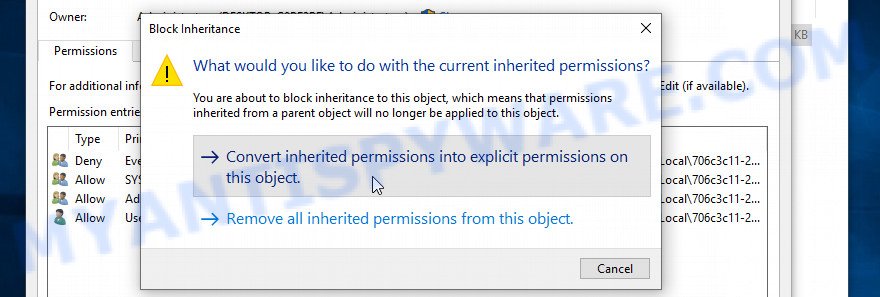
In the Permission entries list, select "Deny Everyone", click Remove button and then OK. Close the file properties window. You should now be able to remove the Maql virus. Right-click on the file and select Delete.
Scan computer for malware
Zemana AntiMalware (ZAM) is a program which is used for malicious software, trojans, adware, ransomware virus, spyware, worms and other security threats removal. The program is one of the most efficient antimalware tools. It helps in ransomware removal and and defends all other types of malicious software. One of the biggest advantages of using Zemana is that is easy to use and is free. Also, it constantly keeps updating its virus/malware signatures DB. Let's see how to install and scan your personal computer with Zemana Anti-Malware in order to remove Maql ransomware from your device.
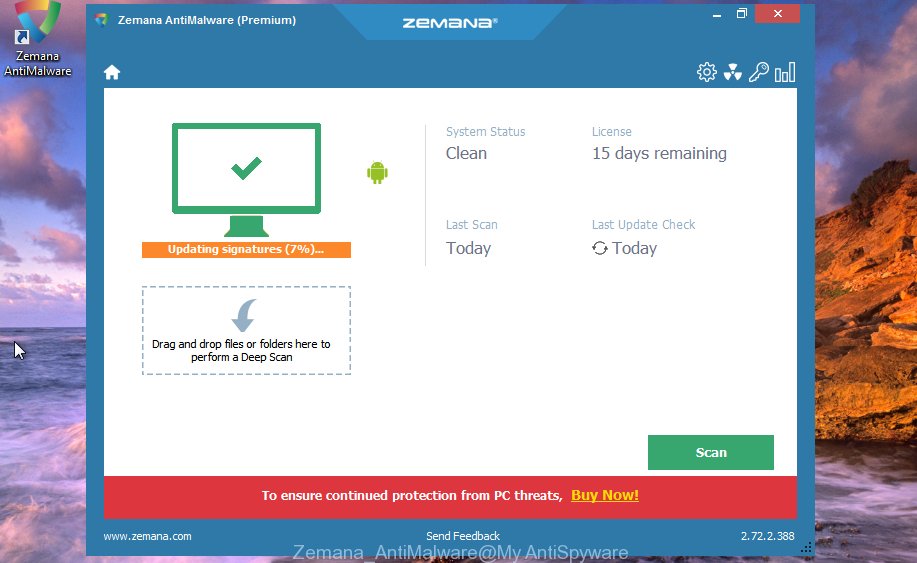
- Download Zemana AntiMalware (ZAM) from the link below.

Zemana AntiMalware
142070 downloads
Author: Zemana Ltd
Category: Security tools
Update: July 16, 2019
- At the download page, click on the Download button. Your internet browser will open the "Save as" prompt. Please save it onto your Windows desktop.
- Once downloading is done, please close all software and open windows on your PC. Next, start a file called Zemana.AntiMalware.Setup.
- This will open the "Setup wizard" of Zemana Anti Malware onto your computer. Follow the prompts and do not make any changes to default settings.
- When the Setup wizard has finished installing, Zemana will launch and open the main window.
- Further, click the "Scan" button. It will scan through the whole system for the Maql crypto virus and other security threats. A system scan can take anywhere from 5 to 30 minutes, depending on your personal computer. While it is scanning, you may see how many objects it has identified either as being malicious software.
- As the scanning ends, you will be displayed the list of all detected threats on your personal computer.
- You may delete threats (move to Quarantine) by simply press the "Next" button. The tool will remove Maql ransomware, other malware, worms and trojans and move the selected threats to the Quarantine. When the process is complete, you may be prompted to restart the device.
- Close Zemana and continue with the next step.
In order to be 100% sure that the computer no longer has the Maql virus, we recommend using the Kaspersky virus removal tool (KVRT). KVRT is a free removal utility for crypto malware, worms, spyware, trojans, adware, potentially unwanted applications and other malicious software.
Download Kaspersky virus removal tool on your computer from the link below.
After the downloading process is done, double-click on the Kaspersky virus removal tool icon. Once initialization procedure is done, you will see the KVRT screen as shown in the following example.
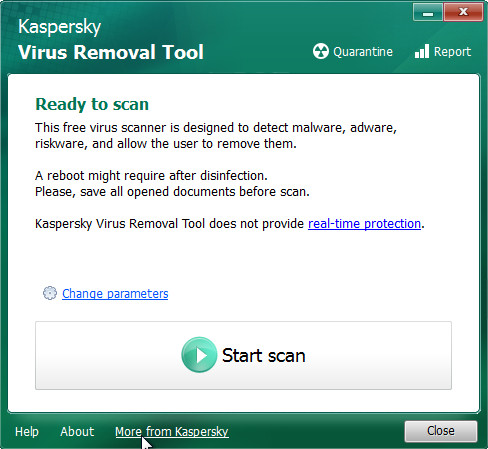
Click Change Parameters and set a check near all your drives. Press OK to close the Parameters window. Next click Start scan button to locate the Maql crypto malware . A scan can take anywhere from 10 to 30 minutes, depending on the number of files on your PC and the speed of your PC. While the Kaspersky virus removal tool utility is scanning, you may see number of objects it has identified as being infected by malware.
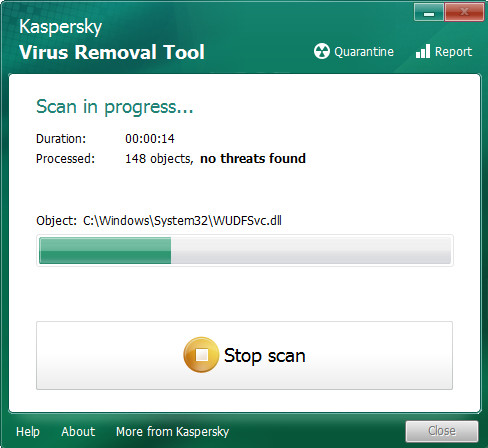
When KVRT is done scanning your PC, it will display a screen that contains a list of malware that has been detected like below.
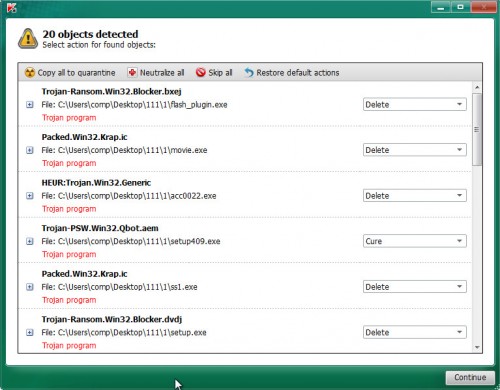
When you are ready, press on Continue to begin a cleaning task.
How to decrypt .maql files
As we already reported above, files with .maql extension are files that have been encrypted by Maql virus. Their contents will remain locked until decrypted using the decryptor and the key. Fortunately, there is a free Maql File Decrypt Tool that can decrypt encrypted files. Below we provide instructions on where to download and how to use the Maql File Decrypt Tool.
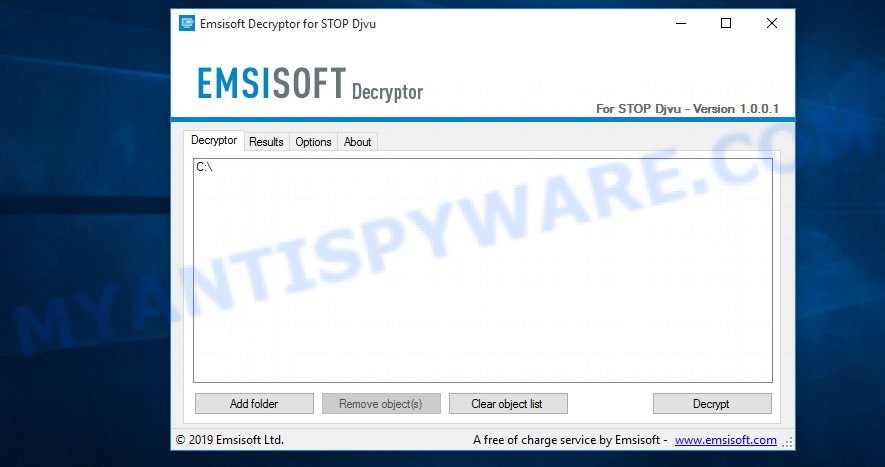
Maql File Decrypt Tool (STOP Djvu decryptor)
To decrypt .maql files, use Maql File Decrypt Tool
- Download Maql File Decrypt Tool from the following link.
STOP Djvu decryptor - Scroll down to 'New Djvu ransomware' section.
- Click the download link and save the decrypt_STOPDjvu.exe file to your desktop.
- Run decrypt_STOPDjvu.exe, read the license terms and instructions.
- On the 'Decryptor' tab, using the 'Add a folder' button, add the directory or disk where the encrypted files are located.
- Click the 'Decrypt' button.
Maql File Decrypt Tool is a free tool that can decrypt files that were encrypted with an offline key, as Emsisoft found a way to find this key. Unfortunately, files encrypted with an online key cannot yet be decrypted. The online key is unique to each infected computer, and at the moment there is no way to find this key. Of course, the Maql ransomware authors own this key, but we do not think that paying a ransom is the right way to decrypt .maql files. In the case when the files are encrypted with an online key, there is a chance to restore the encrypted files using alternative methods, which are described below.
How to find out which key was used to encrypt files
Since Maql File Decrypt Tool only decrypts files encrypted with the offline key, each ransomware victim needs to find out which key was used to encrypt the files. Determining the type of key used is not difficult. Below we give two ways. Use any of them.
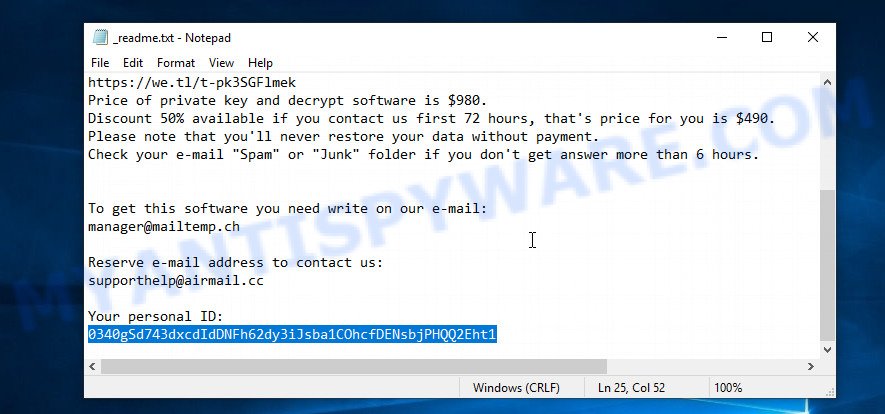
Personal ID is highlighted here
Find out the type of key using '_readme.txt' file
- Open the ransom demand message ('_readme.txt' file).
- Scroll down to the end of the file.
- There you will see a line with the text 'Your personal ID'.
- Below is a line of characters that starts with '0340' – this is your personal id.
Find out the type of key using 'PersonalID.txt' file
- Open disk C.
- Open directory 'SystemID'.
- Open file named 'PersonalID.txt'. This file lists "Personal ID"s that match the keys that the virus used to encrypt files.
The 'Personal ID' is not a key, it is an identifier related to a key that was used to encrypt files. If the ID ends with 't1', then the files are encrypted with an offline key. If the ID does not end with 't1', the Maql ransomware used an online key. If you could not figure out how to determine which key was used to encrypt files, then we can help. Just write a request here or in the comments below.
Maql File Decrypt Tool : "No key for New Variant online ID"
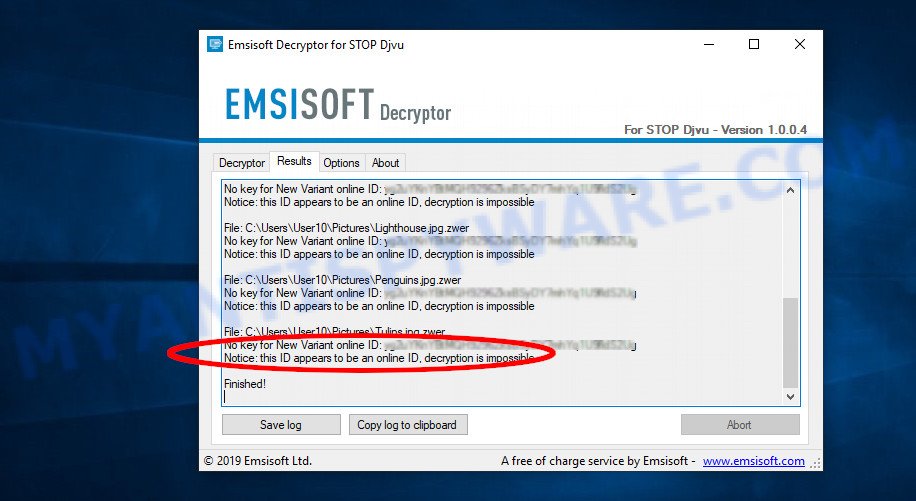
If, when you try to decrypt .maql files, Maql File Decrypt Tool reports:
No key for New Variant online ID: *
Notice: this ID appears to be an online ID, decryption is impossible
It means that your files are encrypted with an 'online key' and their decryption is impossible, since only the maql authors have the key necessary for decryption. In this case, you need to use alternative methods listed below to restore the contents of encrypted files.
Maql File Decrypt Tool : "No key for New Variant offline ID"
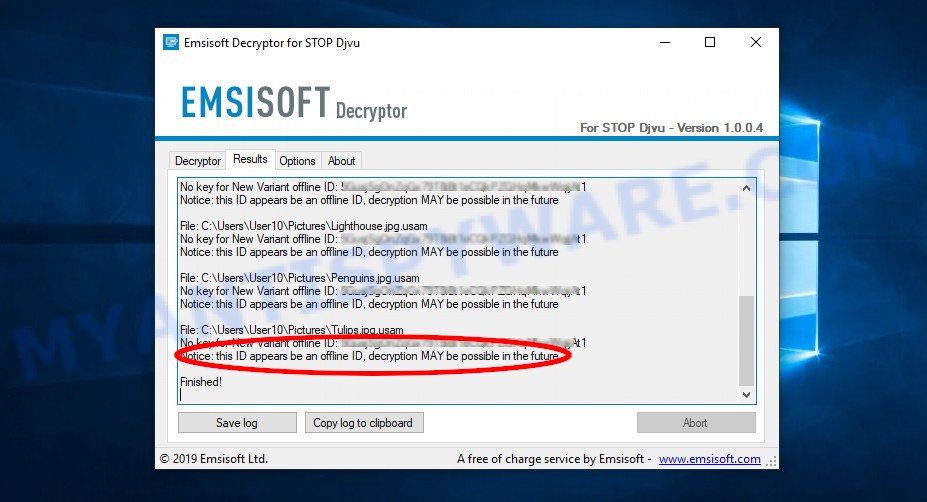
If, during decryption of .maql files, Maql File Decrypt Tool reports:
No key for New Variant offline ID: *t1
Notice: this ID appears be an offline ID, decryption MAY be possible in the future.
It means the following: your files are encrypted with an 'offline key', but the key itself has not yet been obtained by security researchers, in this case, you need to be patient and wait a while, in addition, you can also use alternative ways for recovering encrypted data.
If for some reason you were unable to decrypt the encrypted files, then We recommend to follow the news on our Facebook or YouTube channels. So you 'll know right away that it 's possible to decrypt .maql files.
This video step-by-step guide will demonstrate How to remove Maql virus, Decrypt/Recover .maql files.
How to restore .maql files
As we mentioned above, in addition to using the Maql File Decrypt Tool, there are several more methods for recovering encrypted files. These methods do not require the use of a decryptor and a key, and therefore are suitable for all cases when the virus used an online key, and for the case when the virus used an offline key. It is very important to check your computer for malware before you try to recover encrypted files. You must be 100% sure that Maql virus is completely removed. To scan your computer for ransomware, use free malware removal tools.
Use shadow copies to recover .maql files
The Microsoft Windows has a feature called 'Shadow Volume Copies' that can help you to recover .maql files encrypted by the ransomware. A small tool called ShadowExplorer will allow you to easily access the Shadow copies and restore the encrypted files to their original state. Unfortunately, the ransomware can delete these Shadow copies before it starts encrypting files. Therefore, if ShadowExplorer did not help you, then try another method, which is given below.
ShadowExplorer can be downloaded from the following link. Save it on your MS Windows desktop.

ShadowExplorer
301210 downloads
Author: ShadowExplorer.com
Category: Security tools
Update: September 15, 2019
After the download is complete, extract the saved file to a folder on your PC system. This will create the necessary files like the one below.
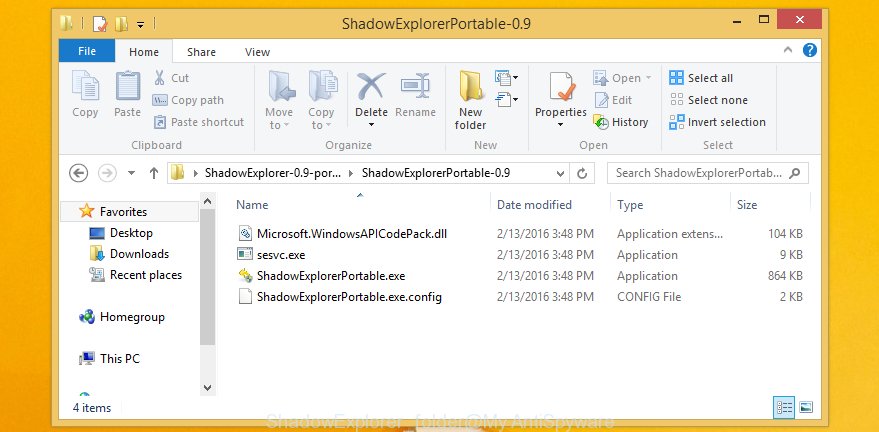
Start the ShadowExplorerPortable program. Now choose the date (2) that you want to recover from and the drive (1) you want to restore files (folders) from as displayed on the image below.
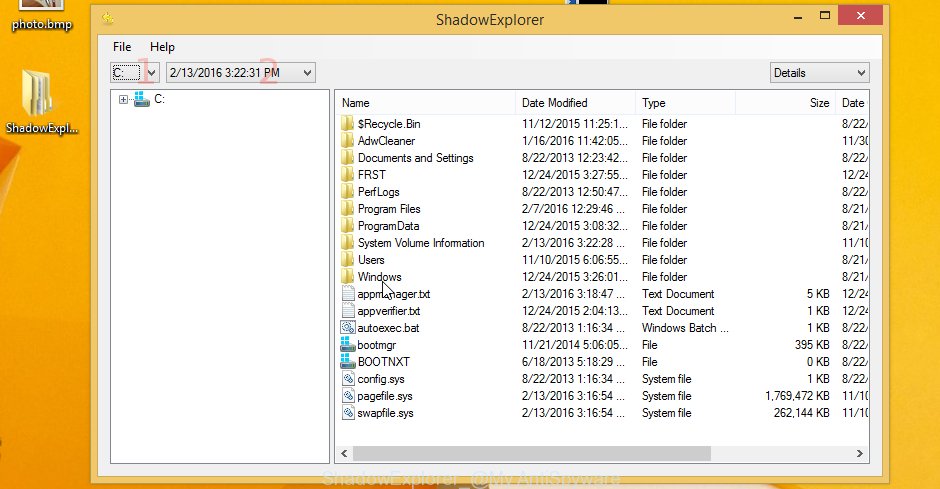
On right panel navigate to the file (folder) you want to recover. Right-click to the file or folder and press the Export button as shown below.

And finally, specify a directory (your Desktop) to save the shadow copy of encrypted file and press 'OK' button.
This video step-by-step guide will demonstrate How to recover encrypted files using Shadow Explorer.
Use PhotoRec to recover .maql files
The last chance to restore .maql files to their original state is using data recovery tools. We recommend a program called PhotoRec. It has all the necessary functions to restore the contents of encrypted files. It helped many victims recover data when it seemed like there was no more hope.
Download PhotoRec from the link below.

PhotoRec
152696 downloads
Author: CGSecurity
Category: Security tools
Update: March 1, 2018
Once downloading is finished, open a directory in which you saved it. Right click to testdisk-7.0.win and select Extract all. Follow the prompts. Next please open the testdisk-7.0 folder like the one below.

Double click on qphotorec_win to run PhotoRec for Microsoft Windows. It'll display a screen like below.
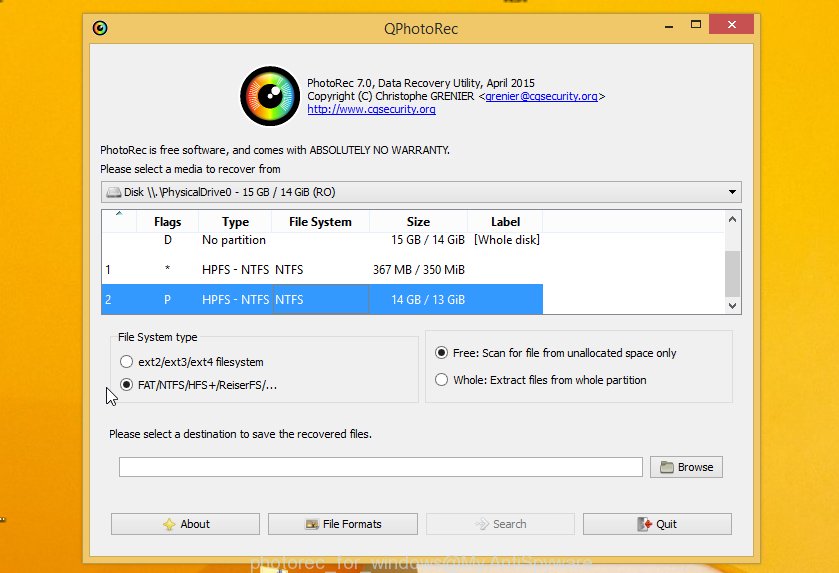
Select a drive to recover like below.

You will see a list of available partitions. Choose a partition that holds encrypted photos, documents and music as on the image below.

Click File Formats button and choose file types to recover. You can to enable or disable the recovery of certain file types. When this is complete, click OK button.
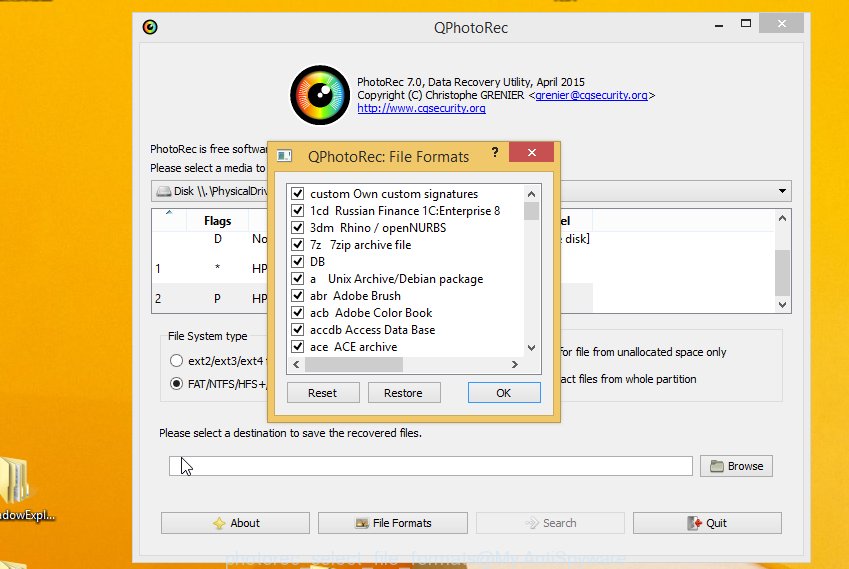
Next, press Browse button to choose where restored documents, photos and music should be written, then click Search. We strongly recommend that you save the recovered files to an external drive.
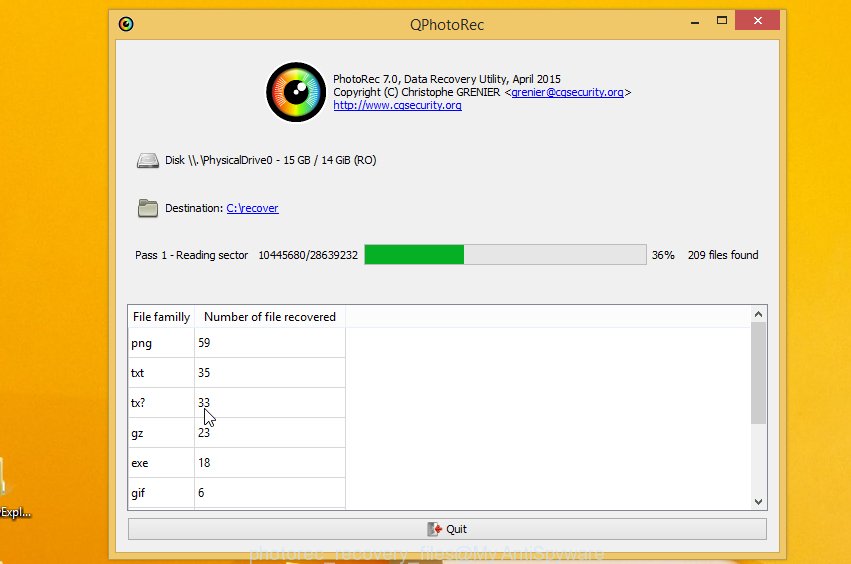
Count of restored files is updated in real time. All restored photos, documents and music are written in a folder that you have selected on the previous step. You can to access the files even if the recovery process is not finished.
When the recovery is finished, click on Quit button. Next, open the directory where restored files are stored. You will see a contents as displayed in the following example.
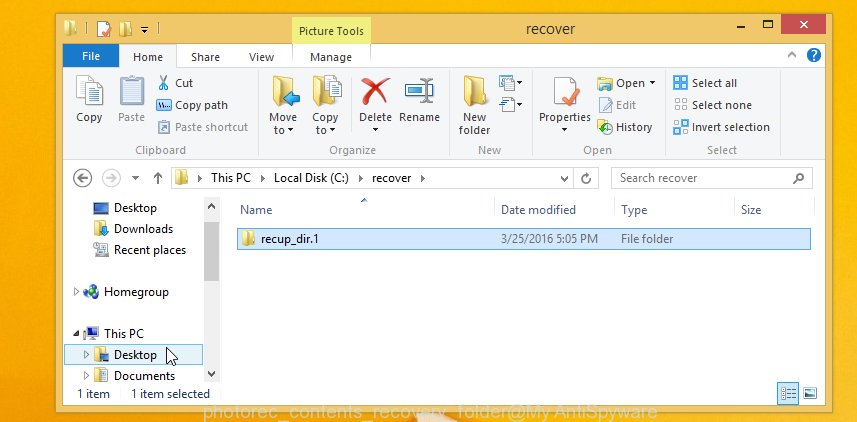
All recovered personal files are written in recup_dir.1, recup_dir.2 … sub-directories. If you are searching for a specific file, then you can to sort your recovered files by extension and/or date/time.
This video step-by-step guide will demonstrate How to recover encrypted files using PhotoRec.
How to protect your PC from Maql ransomware
Most antivirus software already have built-in protection system against the ransomware virus. Therefore, if your computer does not have an antivirus program, make sure you install it. As an extra protection, run the HitmanPro.Alert. All-in-all, HitmanPro.Alert is a fantastic utility to protect your computer from any ransomware. If ransomware is detected, then HitmanPro.Alert automatically neutralizes malware and restores the encrypted files. HitmanPro.Alert is compatible with all versions of Microsoft Windows OS from Microsoft Windows XP to Windows 10.
Click the following link to download the latest version of HitmanPro.Alert for MS Windows. Save it directly to your MS Windows Desktop.

HitmanPro.Alert
5304 downloads
Author: Sophos
Category: Security tools
Update: March 6, 2019
After the downloading process is complete, open the file location. You will see an icon like below.

Double click the HitmanPro Alert desktop icon. Once the utility is started, you'll be displayed a window where you can choose a level of protection, as shown in the figure below.
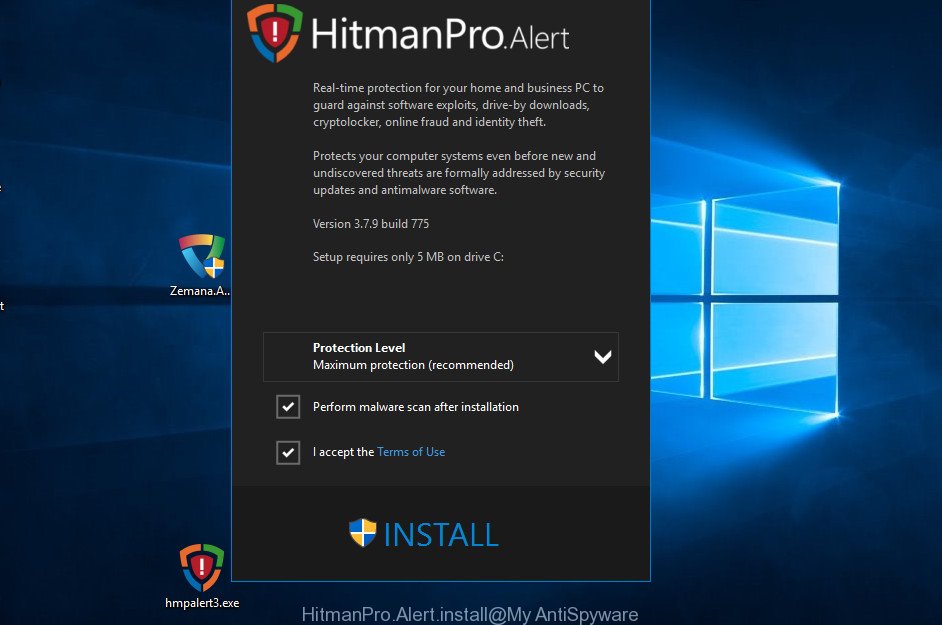
Now click the Install button to activate the protection.
Finish words
This guide was created to help all victims of the Maql ransomware virus. We tried to give answers to the following questions: how to remove ransomware; how to decrypt .maql files; how to recover encrypted files; what is an online key and what is an offline key. We hope that the information presented in this manual has helped you.
If you have questions, then write to us, leaving a comment below. If you need more help with Maql related issues, go to here.




 (1 votes, average: 5.00 out of 5)
(1 votes, average: 5.00 out of 5)
![]() Loading...
Loading...
How to Open a Pkpass File in Windows 10
Source: https://www.myantispyware.com/2021/10/21/how-to-remove-maql-ransomware-decrypt-maql-files/